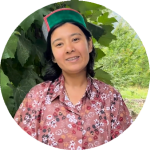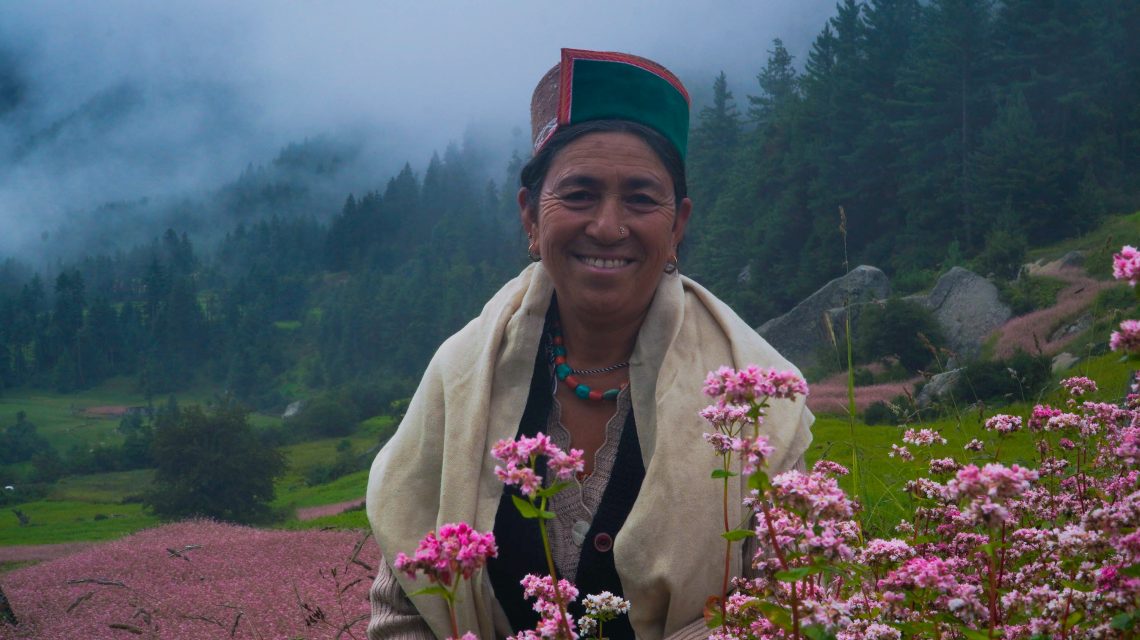
Buckwheat- A Heritage Grain on the Brink?
The threat to Buckwheat and its impact on the Western Himalayan Communities
Journey with the author through Western Himalaya as she weaves together the story of buckwheat farming. She compares the traditional practices of her aunt’s village in Rakchham, in the picturesque Kalpa Valley in Kinnaur, Himachal Pradesh, with that of the resilient Shauka community in Johar Valley, Uttarakhand. This exploration uncovers how buckwheat, a hardy yet humble crop, remains deeply rooted in the cultural identity of these regions. Amidst changing climate and challenges of modernity, farmers adapt, balancing age-old customs with new practices. The story captures the evolving relationship between people and the land, highlighting the perseverance of mountain communities in their bid to preserve their agricultural heritage.
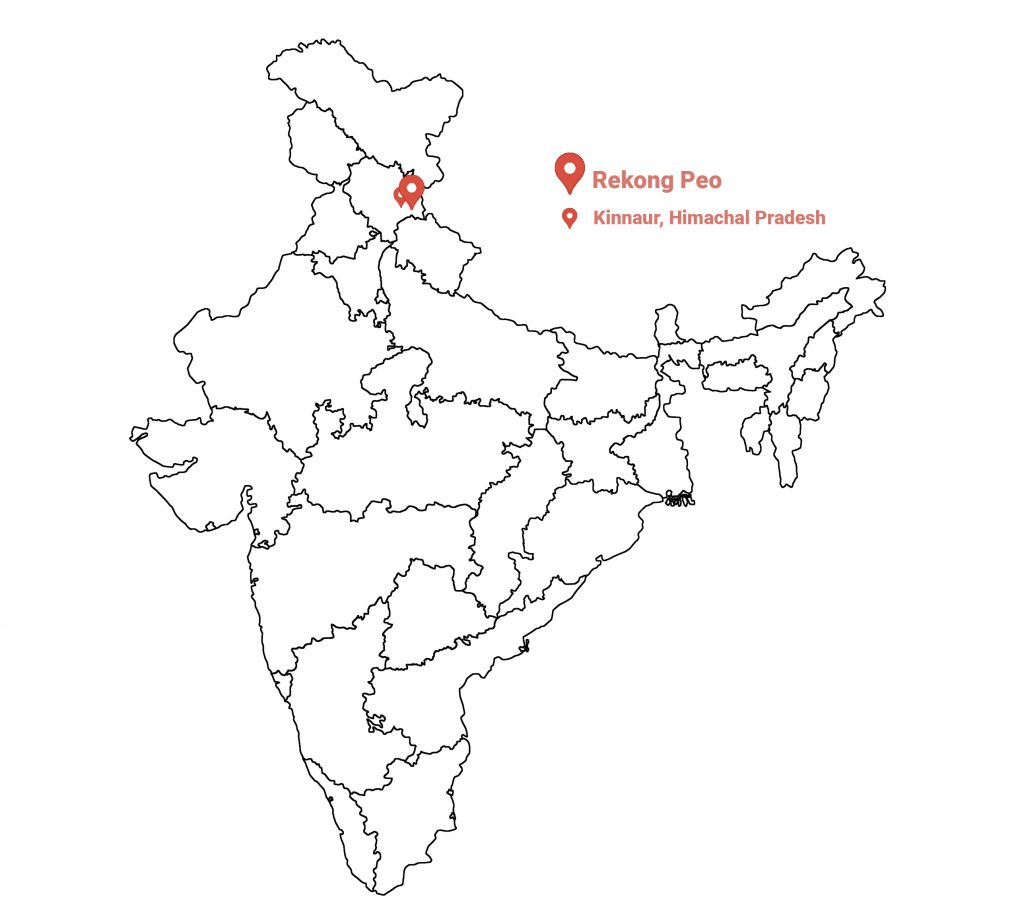
Storyteller : Pramiti Negi
Himal Prakriti Fellow
Rekong Peo, Kinnaur District,
Himachal Pradesh
Read this story in Hindi
An August’s morning mist envelops us. I accompany my aunt, Inder Devi, as we make our way through the hazy rows of her buckwheat field, the contours of lovely white and pink petals softened by the damp air. My aunt tugs at the weeds cautiously while humming a melody. As I stand there soaking in the atmosphere, I can’t help but think of an old Kinnauri folk song that describes how this resilient crop was once cherished alongside seven other traditional crops; now obscured by apple orchards.
She sings it upon my request, “…Hey, oh! In one row, plant Wheat and in one (row) Buckwheat. Hey, oh! It grew well, seven different types (of seeds), It grew well.”
My aunt has a melodious voice and she has been a buckwheat farmer for over thirty years. Her notes blend with the far-off bubbling of the Baspa River as the early morning sun starts to break through the blanket of fog. Her village Rakccham, perched at over 3,048 metres along the banks of the Baspa River, reveals itself slowly through the mist. Quaint houses and sprawling apple orchards are on the right bank of the river. The left bank, where we stood, has lush pastures, with tourist lodgings tucked along the slopes of the meadows below us, with fields of buckwheat ascending on the hillside above.
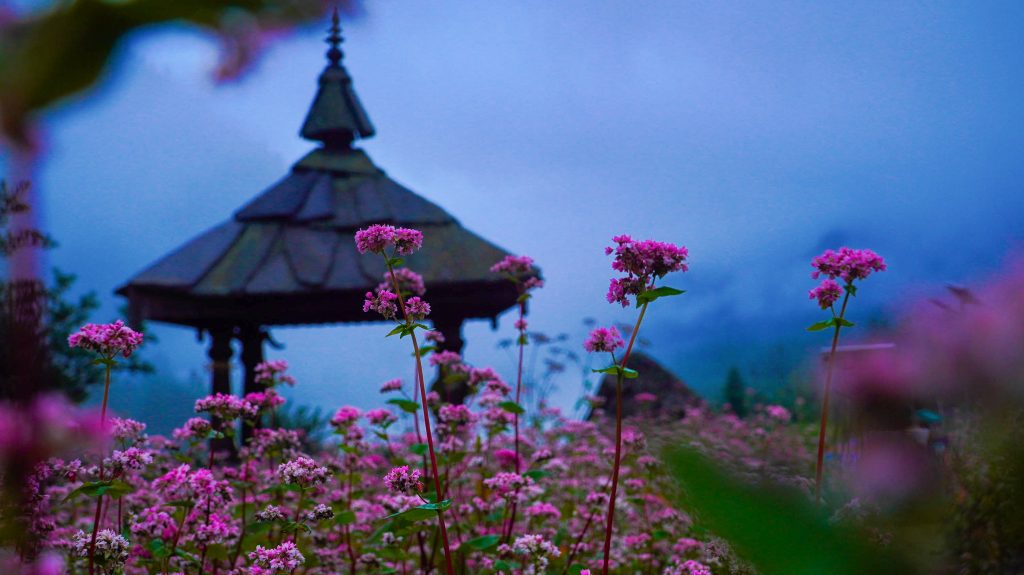
Sang Githang, sung at the sang bela or the breaking of dawn during festive occasions, becomes perfectly timed with the fog’s retreat and the dawning of colours to an earlier muted landscape. Invigorated by the aroma of dew-kissed earth and flowering buckwheat, the air is crisp and fresh.
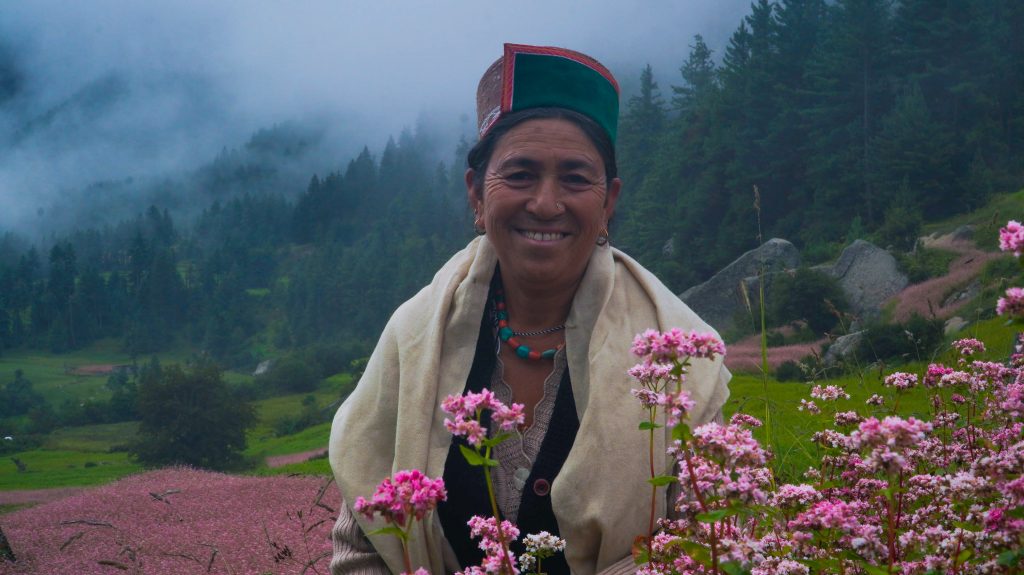
In this picturesque landscape, two distinct varieties of buckwheat grace the fields, each adding its charm to the scenery. As you gaze upon the patch of common buckwheat, known locally as Olgo (Fagopyrum esculentum), you see a vibrant canvas of pink from a distance.
In contrast, the flowers of Tartary buckwheat (Fagopyrum tataricum) known as Bras, with their softer and more delicate white hues, merge perfectly with their heart-shaped green foliage from afar. Together, these two varieties paint the landscape with beautiful interplay of colours.
Despite its name, buckwheat isn’t a grain or wheat; it is a seed from a plant in the Polygonaceae family, milled into flour and used similarly to a cereal. Much like their colours, their taste too differs. Common buckwheat offers a milder, nutty taste and smoother texture. Tartary buckwheat has a robust, earthy, and slightly bitter flavour, with a coarser texture. As time passes, Aunty’s hand movements while she weeds become slower. I grab the opportunity to shoot my questions and ask her to take me through the process of growing buckwheat.
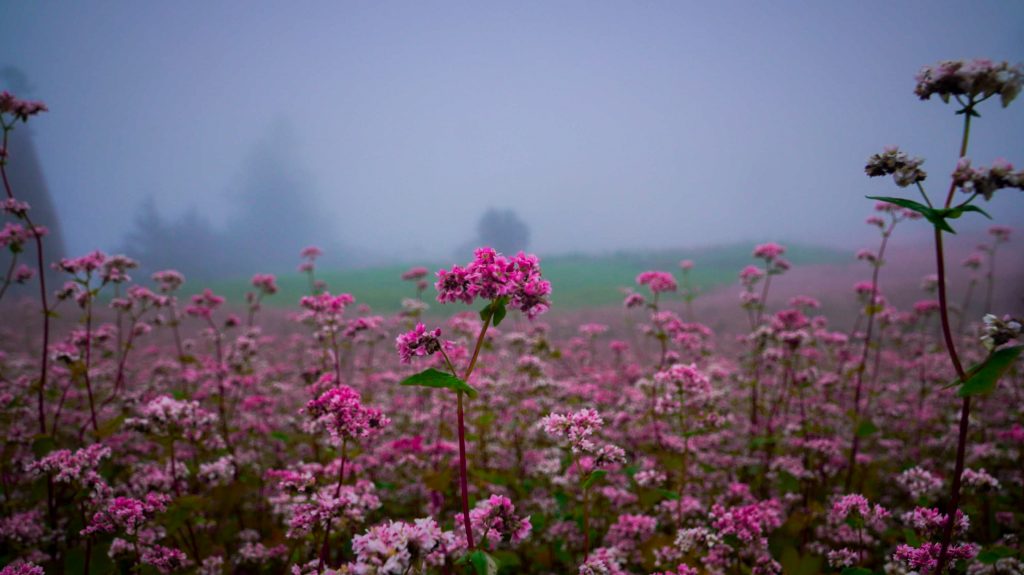
The sowing of buckwheat is done late in May. My aunt explains that when she was young Bras and Olgo were sown a week apart, with Bras planted earlier and followed by Olgo a week later.
She says, “In those days the land was tilled with a bull or a Dzo (a hybrid of yak and cow). But with the advent of hand tillers and apple farming keeping everyone occupied, both the varieties are sown at the same time now.”
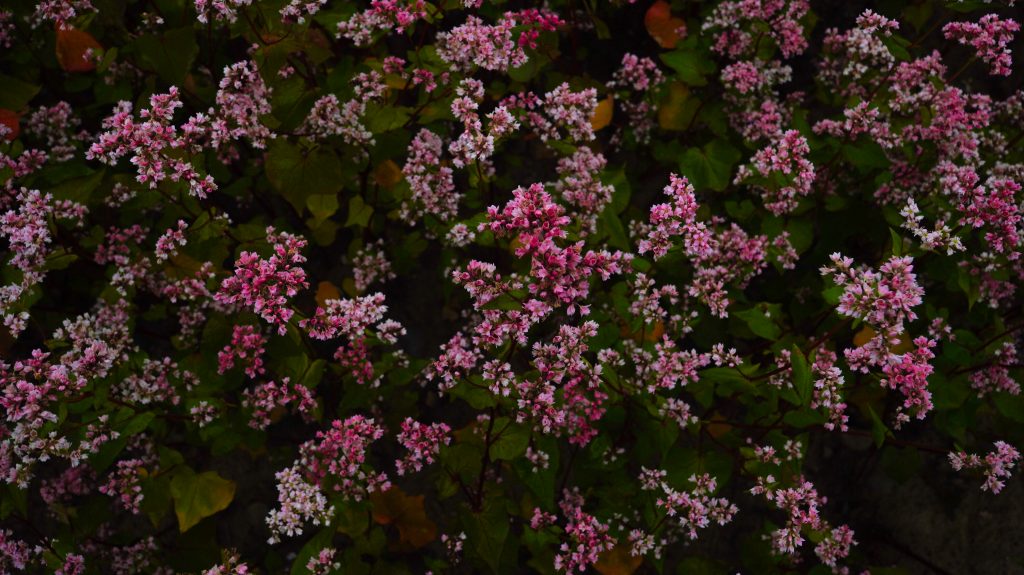
Buckwheat is an annual crop that matures quickly in 70 to 90 days. Within a few weeks of planting, the fields are adorned with a sea of white and pink flowers. The flowers are tiny, delicate clusters with each blossom no larger than a fingernail. During the bloom in the middle of July through mid-August, the fields come alive with movement and sounds of nature. As I stood in my aunt’s farm, I could hear the soft rustle of leaves and the light buzz of bees busy at work. Buckwheat’s capacity to promptly cover the soil decreases soil erosion and creates an environment favourable for microorganisms thus increasing soil fertility. Its accelerated growth rate also allows it to outgrow most weeds. Hand weeding in buckwheat cultivation typically occurs twice per cycle.
My aunt was conducting the second cycle of weeding called hass arr. The initial weeding, known as mann arr, addresses general weed removal while this second cycle is to weed out the Tartary buckwheat from the lot of common buckwheat to prevent their seeds from mixing. Additionally, it is important to highlight that this indigenous plant is grown without any chemicals or fertilisers across Kinnaur.
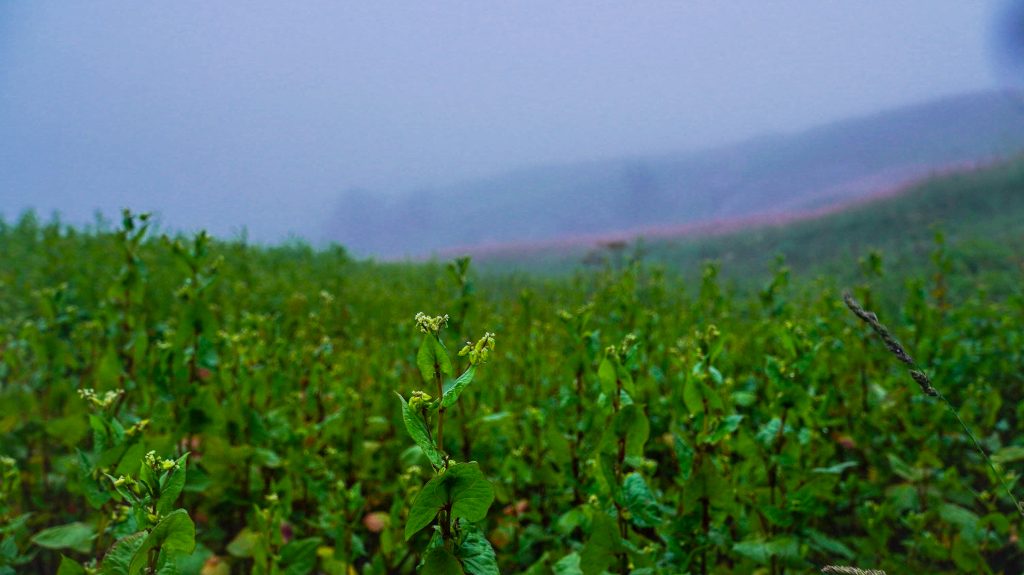
As September rolls in, buckwheat begins to set seeds, reaching its peak for harvest by mid-month. My aunt eagerly invites me to visit at the time, and I feel a tug of temptation, even as uncertainty about my schedule lingers in my mind. Sensing my dilemma, she smiles and begins to explain the harvest process, her passion infectious.
Harvesting begins with cutting the mature plants and leaving them to dry in a well-ventilated area for 7 to 10 days, allowing the moisture in the seeds to evaporate and making it easier to separate them from the chaff. Once dried, the plants are threshed and cleaned. The cleaned buckwheat seeds are then ground into flour using a mill. After milling the flour is sifted and stored.
Rakccham has emerged as the major producer of buckwheat across Kinnaur, and its flour is highly sought after in the local market. Buckwheat is important for the food security of the region adding essential protein, vitamins and minerals to the local diet. It is consumed as various food items. Hod/hodo or crepes, doo is a savoury dish with the consistency of Halwa and deep-fried snacks that look similar to Jalebi known as this poley are some of the common dishes. Even today a social gathering is incomplete without serving the guests some buckwheat crepes- a mild nutty delicacy eaten with honey and unsalted butter.
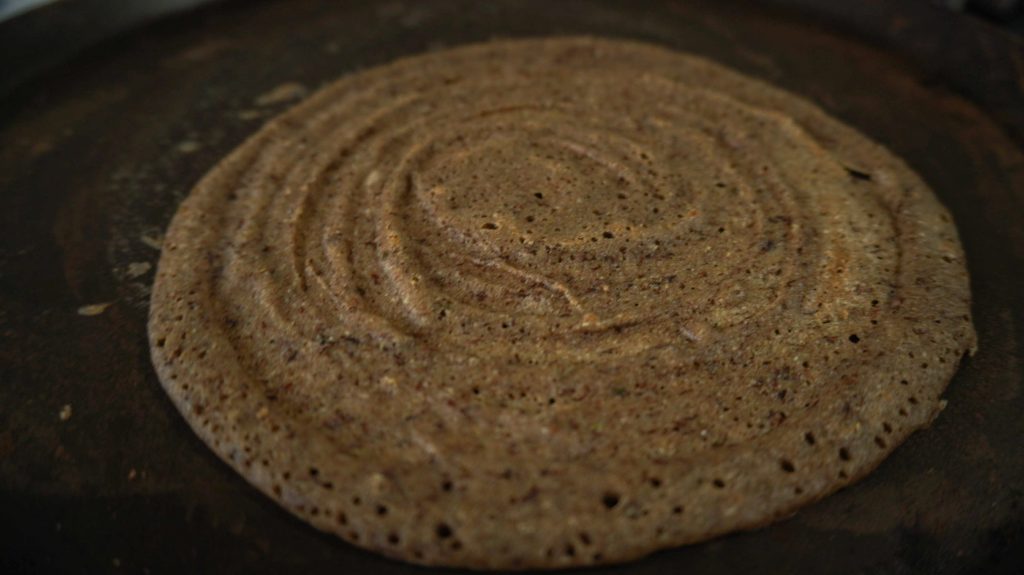
The Sairag Valley where I live is located northwest of my Aunty’s village. Here, Buckwheat is confined to the kandey where open fields without apple plantations and higher elevations allow for the cultivation of Buckwheat. Settlements in Kinnaur often include a lower village area and higher fields or pastures. Kandey refers to higher farming lands located above the village settlement used for summer grazing and growing hardy crops and medicinal herbs.
Last July, my friend invited me to trek above his kandey. His village Telangi (one of the villages in Sairag) is at an elevation of approximately 2400 m and their kandey at 3200 m.
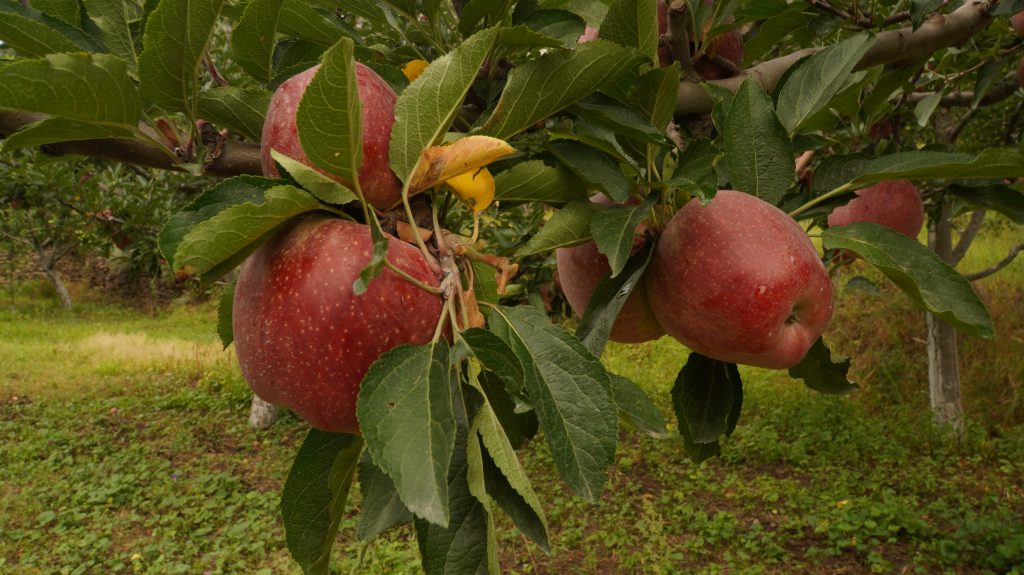
Telangi kandey has recently become accessible by road. But my friend tells me that long before the arrival of roads, many people including their family had started planting apple orchards in there.
He says, “Earlier the apples that grew in our kandey did not give good size and colour. There were no roads and the kandey were not accessible due to snowfall at those altitudes. The rise in temperatures has extended the growing season and improved the growing conditions for apples.”
A similar point regarding the expansion of apple farms was highlighted by Mr Sushil Kumar, my aunt Inder Devi’s husband and a skilled apple farmer from Rakccham.
“Previously, buckwheat was grown in large quantities in our neighbouring villages of Batseri and Sangla. However, over time, apple farming has gradually replaced buckwheat as the primary agricultural activity. Commenting upon the area of cultivation for buckwheat he adds, “We grow buckwheat in the same fields where our forefathers grew them. The left bank of the Baspa River where we grow our buckwheat, is prone to floods and snow accumulation. It is a shaded area with no sunlight, unsuitable for growing apples. Additionally, buckwheat in Rakccham has a huge local demand selling for up to Rs.150/kg in Kinnaur.”
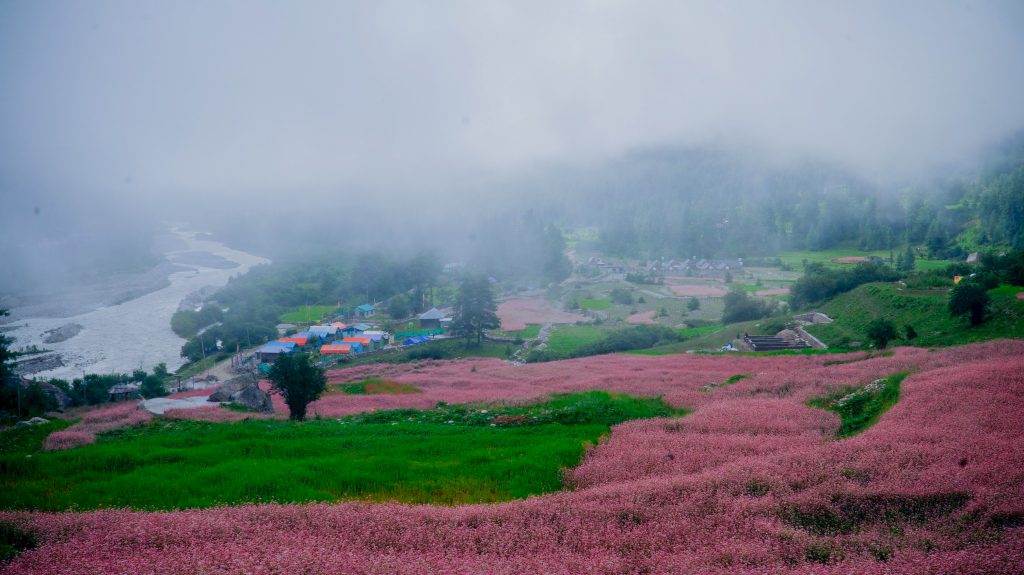
Farmers across Kinnaur unanimously attest to the remarkable resilience of buckwheat, allowing it to thrive in varying temperatures and high-altitude terrain. Many have found that they can eliminate the need for canal irrigation, known as Tee Paling, with the buckwheat thriving on rain and moisture in the air. However, growing buckwheat in the same field as mature apple trees is tough as it inhibits the growth of buckwheat. Apples also require constant care such as pesticides, fungicides, and nutrient sprays.
My friend’s mother, Mrs Sanjog Kumari tells me, “As a generational farmer, it would be awkward to not have buckwheat even for self-consumption. We have a small patch of land where the apple plantation has not yet matured. We rotate between Olgo and Bras there. But if there is a function in the family, we buy more of it from our friends and family who grow buckwheat in abundance.”
The daily consumption of buckwheat on average has gone down to once a month or weekly as opposed to daily consumption in the past. Store-bought rice and wheat have long become the staple of people’s diets.
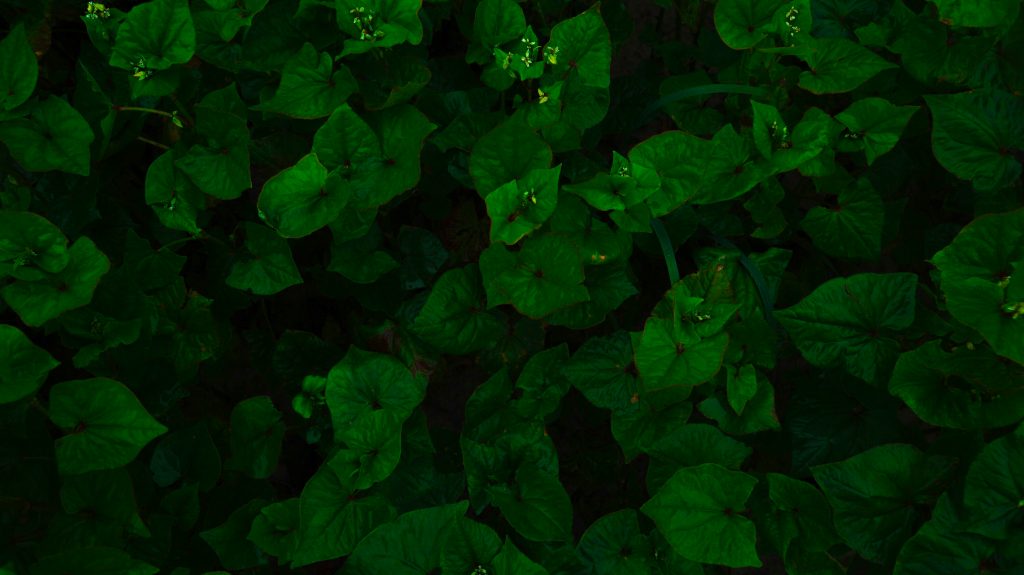
During the trek, I also observed that in higher elevations where apples did not thrive, many people grew peas instead. Peas like pples have a better export network. As we pondered over the rapid increase in commercially lucrative crops, my friend narrated a story told to him by his Palas Api meaning Shepherd grandmother. Palas Api was his family acquaintance from the neighbouring village of Pangi.
His seventy year old Api told him that the story is based on real-life events that she heard as a child. On a cold winter night, a man had gotten lost in the forests of Pangi. As if things weren’t already bad, he fell into a ditch so deep that there was no way he could get out on his own. To his surprise, in the ditch, a bear was hibernating. The man took out his knife and gutted the bear and foundkoylang of Buckwheat. For four months he survived on the koylang that he drew out of the bear’s stomach.
It is said that a bear seeks to max out on nourishment before hibernating and buckwheat happens to be the food a bear loves consuming. Koylang is when flour is mixed with water into a runny batter with which crepes are prepared. Because the bear had consumed a lot of buckwheat before hibernating, the Palas-Api believed the partly digested contents of the bear’s stomach were full of nutrition and kept the man alive till rescue arrived. There is no way to confirm the details of the story but one thing is certain, buckwheat is a nutrient-dense wonder.
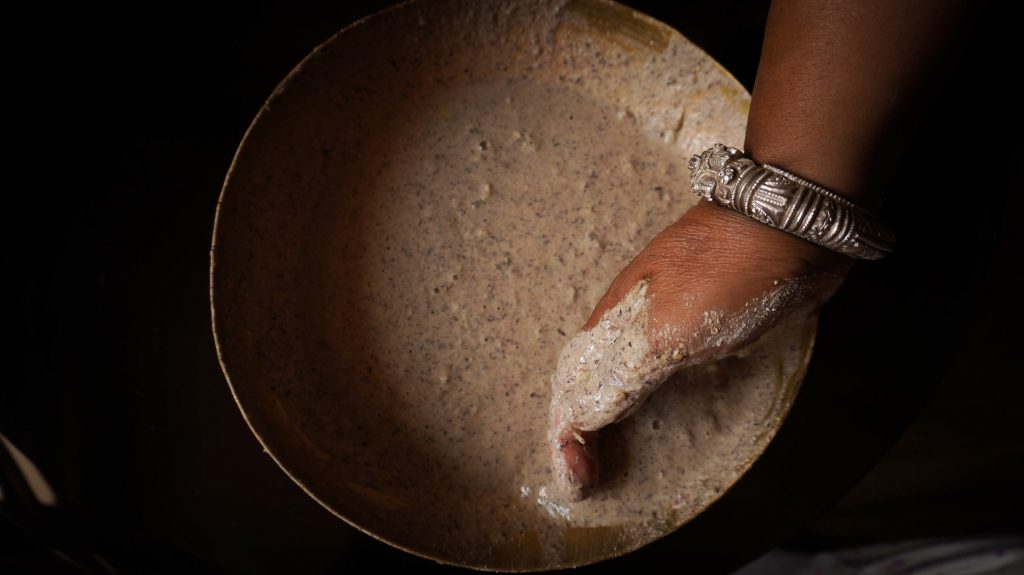
Buckwheat’s numerous benefits, including its minimal input requirements, soil health improvement, and low impact on the environment, make it an ideal crop for maintaining agricultural sustainability. To gain a deeper insight into buckwheat farming and related aspects, I had the opportunity to speak to members of the Shauka community from Munsiari in Uttarakhand. Shaukasare a specific group from the larger Bhotiya community from the Johar valley in Pithoragarh district. They have historically practised transhumance and engaged in trade along the Indo-Tibetan border. With the annexation of Tibet by China and the imposition of the trade ban across the border in 1962, they transitioned to settling in the lower Himalayan regions and practising seasonal migrations. The 13 ancestral villages of the Shaukas in Johar Valley are now occupied only during the summer months. During this time, the Shaukas focus on traditional farming, growing crops such as Caraway, Wild Chives along with Buckwheat.
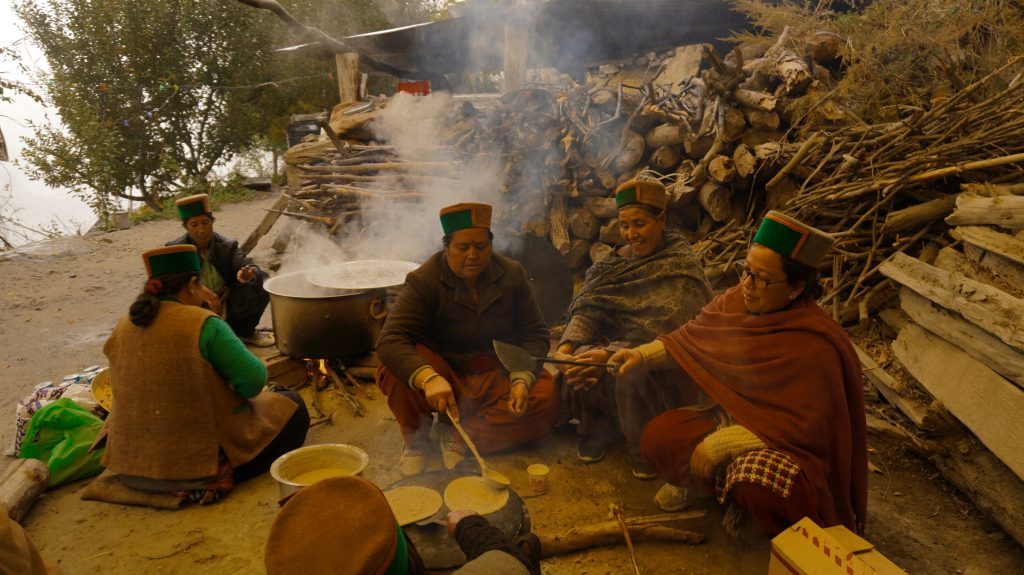
60-year-old Hirma Sumtiyal whose ancestral village is in Sumtu but has now settled in Sarmoli tells me that she has never visited her ancestral village. For the nimble-footed, the trek to Johar Valley from Sarmoli takes two days. Through our conversation, it felt as if Hirma Sumtiyal’s memories of her ancestral village are through remnants such as traditional foods and stories from her husband and mother-in-law. She fondly recounts her love for traditional dishes, such as Shildu– raw buckwheat dough kneaded with water and eaten with Sea buckthorn chutney. She notes that this dish is seldom enjoyed today but is excellent for digestion.
When I asked her, “buckwheat doesn’t grow in Sarmoli. If you don’t visit your ancestral village, are these traditional foods still relevant?”
To which she replies, “During a wedding ceremony making Chuoch is a must. The priest prepares two conical shape with chunks of buckwheat dough and adds a strand of Doob grass (Dactylorhiza) on each. The bride and groom toss the chunks in the air and this ceremony is a must as it is a propitiation of the gods and dieties.”
“From where do you get the buckwheat flour then?” I asked.
“People who seasonally migrate to the upper regions of the Johar valley give it as pathon (gift) or we buy it from the market.”
She hesitates and continues “or we now use rice as a substitute.”
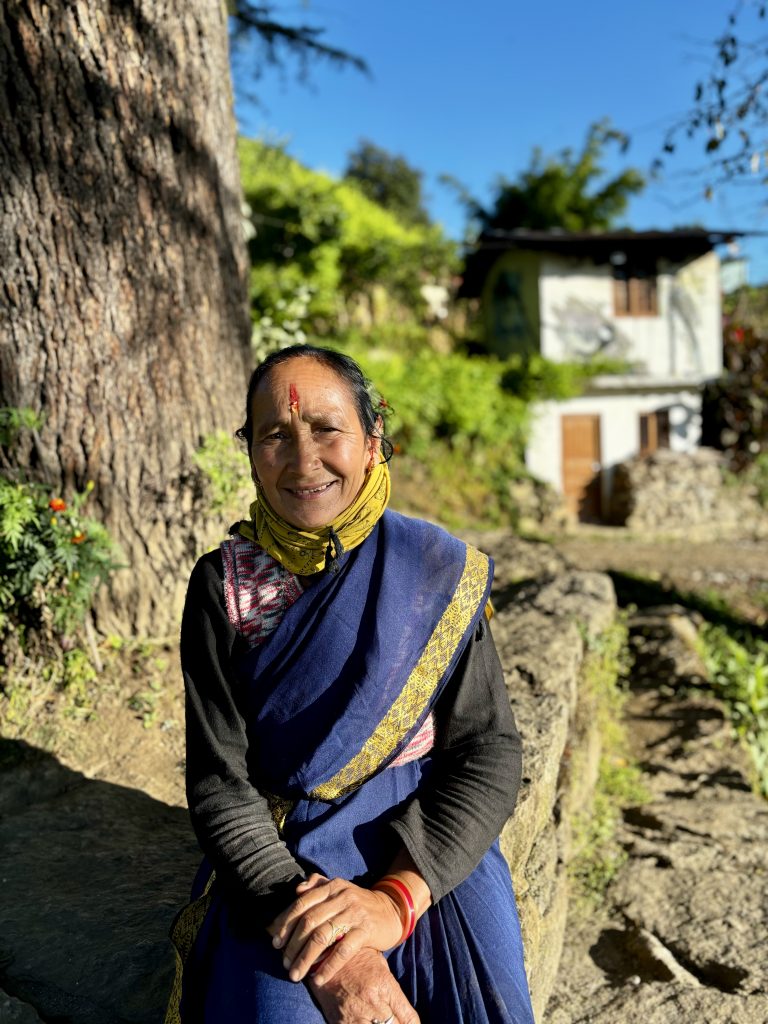
Pathaun is given to loved ones in the form of a gift of food, and a similar tradition exists in Kinnaur under the name Tenfach.Talking to Hirma ji made me realize what happens when the physical connection to ancestral land is lost or changes. Traditional foods like buckwheat embody the essence of cultural identity and family bonds. They carry the flavors, practices, and stories of past generations and keep us connected to our roots.
The question now arises, will the communities that cultivate this hardy plant accommodate its resilience in retaining their roots and values? Or will the verses of songs such as Sang Geethang that originally rejoiced the diverse farming practices be bearers of the sense of loss, waning with whispers of crops that have become less desirable as a result of monocropping and shifting practices? With factors like climate change disrupting the equilibrium of our already vulnerable Himalayan landscape, what implications will the disappearance of crops like buckwheat hold for the future?
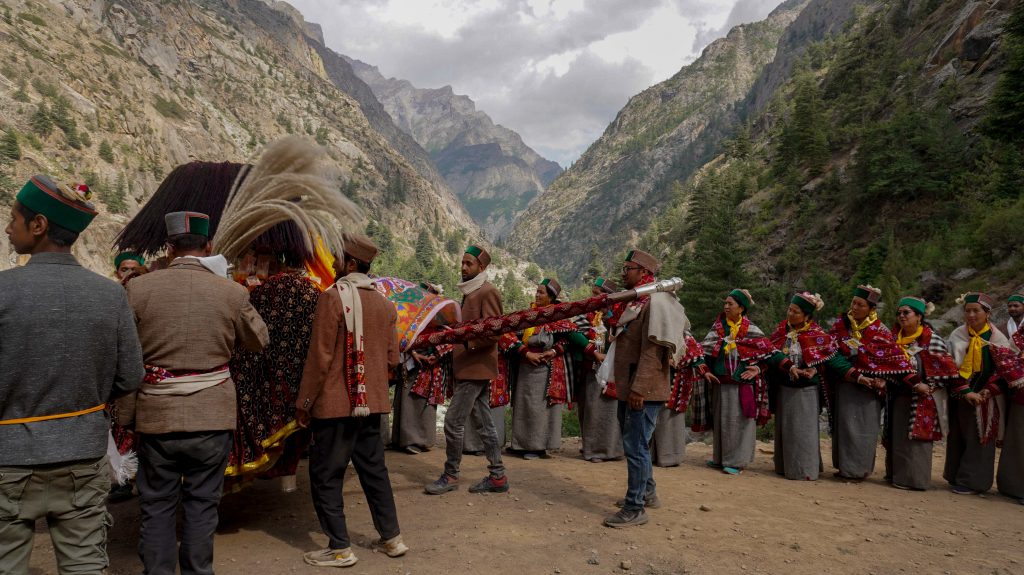
Meet the storyteller



